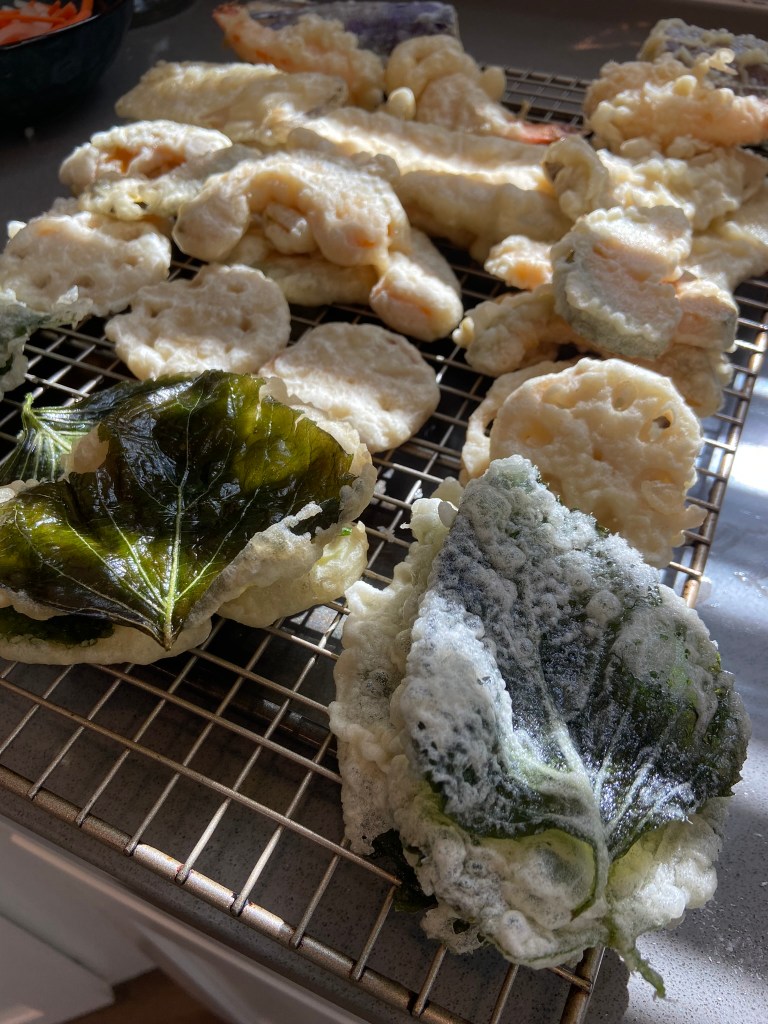Did you know tempura is not Japanese in origin? I learned that it is actually Portuguese and derives from the Latin word “tempora” referring to the time spent fasting from eating meat, which also contributes to why you mainly see vegetables used. The main components of tempura are the vegetables and seafood covered in tempura batter and fried along with dipping sauce (or tentsuyu) and/or flavored salts.
Making the Dish
When I started researching for this week, I assumed that it would be a very simple undertaking – prep the veggies and shrimp, prep the batter, and fry. After watching several different videos on how to make tempura, I realized that the process was more technical and complex than I had initially thought. For one, prepping and cleaning the shrimp eats up so much time. You have to cut off the tip of the tail and then squeeze out any water and dirt, otherwise it could explode. Then, you peel and devein, and have to make small incisions on both sides of the shrimp so that it doesn’t curl up. When prepping the ingredients, the vegetables and seafood should be as dry as possible and be coated in flour before dipping into the batter. It is important to cut the vegetables to the right thickness, and for the eggplant in particular, it is recommended to slice them in a way that creates a fan shape to allow the water to cook out faster.
To give myself even more of a challenge, I tested 3 different tempura batters:
1) Rie’s recipe using cake flour and ice cold water
2) the recipe from TabiEats using all-purpose flour and cold soda water
3) tempura batter I bought from an Asian grocery store with ice cold water
According to TabiEats, the use of the cold soda water is to provide even more lightness and crispiness to the batter. Ice cold water in general helps to prevent the batter from forming gluten and the batter should not be overmixed, which is why using chopsticks to mix is preferable.
There are lots of different vegetables you can use. I personally used king oyster mushrooms, kabocha squash, Japanese eggplant, shiso/perilla leaves, lotus root, and onion and carrot for kakiage, or crispy vegetable fritters. As Takahiro mentions in the Munchies video, kakiage is meant to be the last item eaten at tempura restaurants, so the sliced onions and carrots are thrown into the remaining batter and form delicious crispy vegetable fritters reminiscent of pakora, or Indian vegetable fritters.
For dipping, I opted for a classic dashi and soy sauce-based sauce and used the recipe from Just One Cookbook. Takahiro also shows use of yuzu and nori salt, and daikon oroshi (or, raw grated daikon) with ginger. The daikon is meant to aid with digestion of all the oil, so I included it in my meal, making sure to drain out the water after grating as he suggests.



Eating the Dish
The downside of tempura is that it does not stay crispy after sitting out, which was more apparent for me as a food blogger trying to record and take pictures while cooking precisely and taking awhile to do so. Luckily, re-frying them briefly in slightly hotter oil helped to bring back the crispiness, but probably added even more oil than necessary.
In terms of tempura batters, my husband and I personally enjoyed Rie’s cake flour one the most. The tempura mix surprisingly held up in the competition and is great for someone who likes to use mixes that only require the addition of water. While I could see the intention with using soda water, I did not feel that it was worth getting this specific ingredient to use for a batter that wasn’t astronomically better than the cake flour or tempura mix.
As for the veggies, here is my personal ranking by level of enjoyment (if you are a Try Guys fan and have seen Eugene’s Rank King videos, “I’m right, you’re wrong, shut up”):
1. kakiage (onion and carrot fritters): surprisingly delicious with the beautiful crunch, shape, and soft veggies
2. shiso/perilla leaves: shocking to me given that I don’t like them on their own, but the flavor was nicely savory and the thinness of the leaf boosted the crunch factor
3. kabocha squash: I may be biased because I enjoy kabocha squash and sweet potato-esque flavors, but there’s something about the softness in contrast with the tempura crunch as well
4. Japanese eggplant: this may have ranked higher if I had just done slices like I have seen done in restaurants because the fanning cut made it a very bulky bite
5. lotus root: I love lotus root so this could have easily ranked higher, but peeling it was a nightmare; note to self next time to just buy pre-peeled/boiled lotus root
6. king oyster mushrooms: I was sad to put this on the bottom, but the tempura form just highlighted the rubbery texture that most people do not enjoy from mushrooms and it was pretty bland


Summary
If you can’t already tell, I had so much fun with this post. Learning about the intricacies of tempura from my research and conducting my own little “comparative experiment” with the tempura batters put my home chef abilities to the test. Next time, I would definitely stick to just using one tempura batter (you should have seen my countertop!) and use less variety of veggies. Since the shrimp take awhile to clean and prep, I might skip them altogether, but they do have great taste and are well worth the effort. As mentioned, it is good to know that if you don’t have cake flour, you can easily buy tempura mix from your local Asian grocery store and still make high-quality tempura.
YouTube Videos Referenced
Munchies: Takahiro Sakaeda of Nami Nori in NYC
Tasty: Rie McClenny
TabiEats: Shinichi and Satoshi

